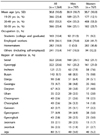Abstract
BACKGROUND/OBJECTIVES
SUBJECTS/METHODS
RESULTS
CONCLUSIONS
Figures and Tables
Table 2

+Based on five statements designed to assess eating behaviors related to salt intake in Korean food culture: 1) I eat salty food more than others (1-5 points), 2) I prefer salty food (1-5 points), 3) I eat more soup and side dishes than others (1-5 points), 4) I often eat liquid-based dishes (stew, soup, noodle soup) (1-5 points), and 5) Usually do not leave the liquid when eating soup and stew (1-4 points). The total possible score ranges from 5 to 24. Cronbach's alpha for the internal consistency of these five items was 0.790.
1)Statistically significantly different between men and women using multiple linear regression adjusting for age groups for continuous variables and chi-square test for categorical variables (P < 0.05).
2)Statistically significantly different among three age groups in all participants using multiple linear regression adjusting for gender for continuous variables and chi-square test for categorical variables (P < 0.05).
3)Statistically significantly different among three age groups in men using ANOVA and chi-square test (P < 0.05).
4)Statistically significantly different among three age groups in women using ANOVA and chi-square test (P < 0.05).
Table 3

1)Statistically significantly different between men and women using multiple linear regression adjusting for age groups (P < 0.05).
2)Statistically significantly different among three age groups in all participants using multiple linear regression adjusting for gender (P < 0.05).
3)Statistically significantly different among three age groups in men using ANOVA and bonferroni adjustment for post-hoc analyses (P < 0.05), different superscript means statistically significantly difference at 0.05 level.
4)Statistically significantly different among three age groups in women using ANOVA and bonferroni adjustment for post-hoc analyses (P < 0.05), different superscript means statistically significantly difference at 0.05 level.
Table 4

1)Statistically significantly different between men and women using multiple linear regression adjusting for age groups (P < 0.05).
2)Statistically significantly different among three age groups in all participants using multiple linear regression adjusting for gender (P < 0.05).
3)Statistically significantly different among three age groups in men using ANOVA and bonferroni adjustment for post-hoc analyses (P < 0.05), different superscript means statistically significantly difference at 0.05 level.
4)Statistically significantly different among three age groups in women using ANOVA and bonferroni adjustment for post-hoc analyses (P < 0.05), different superscript means statistically significantly difference at 0.05 level.




 PDF
PDF ePub
ePub Citation
Citation Print
Print



 XML Download
XML Download